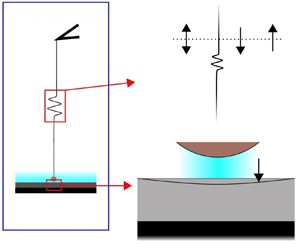Article contents
Generalization of elastohydrodynamic interactions between a rigid sphere and a nearby soft wall
Published online by Cambridge University Press: 30 July 2021
Abstract

Soft substrates, omnipresent in several fundamental processes ranging from the tribological to biophysical, are often subjected to viscous fluid-mediated dynamic loading for their real-time monitoring, by employing advanced characterization tools in the forms of different surface probing apparatus. Here, we bring out exclusive facets of the two-way interplay between large-amplitude loading of a proximal rigid spherical probe on a soft substrate coating and the combined consequences of electrostatic and van der Waals interactions (modelled as Derjaguin–Landau–Verwey–Overbeek (DVLO) forces) on the same. Our results reveal that for high-frequency oscillatory loading and large amplitude of probe motion, the DLVO interactions do not appreciably affect the force response. On the other hand, for low-frequency high-amplitude oscillatory loading, DLVO effects are shown to magnify the substrate deformation tenfold and the force response by up to two orders of magnitude, in experimentally tractable physical limits. Additionally, we find that compressibility of substrate material increases its deformation by approximately a factor of two. Because of the exact shape of the deformable surface as well as the sphere–substrate separation distance being unknown at every time instant a priori, estimation of the resultant force interactions by simply employing an algebraic linear superposition of the different force components is shown to be inappropriate for characterizing the interactions of a highly compliant substrate in close proximity to the dynamically modulated probe. These results may turn out to be of profound importance in rationalizing the interpretation of surface force measurements on soft substrates in several applications encompassing engineering and nano-bio technology.
JFM classification
- Type
- JFM Papers
- Information
- Copyright
- © The Author(s), 2021. Published by Cambridge University Press
References
REFERENCES
- 8
- Cited by


